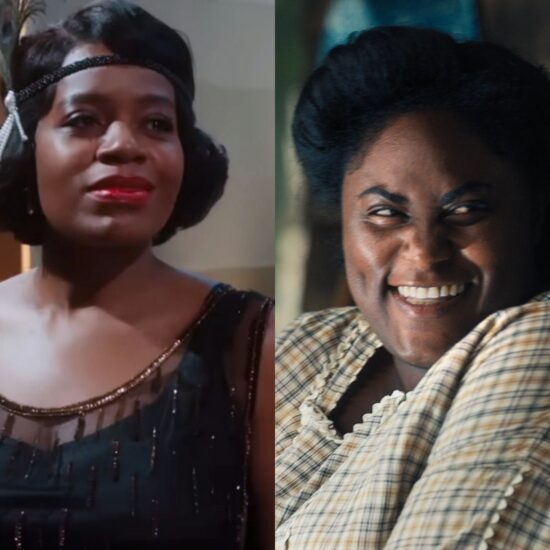
How the Ukrainian frontline became the unlikely setting for this portrait of a halfway house for vulnerable children.
Documentary filmmaker Simon Lereng Wilmont won a Peabody Award in 2017 for “The Distant Barking of Dogs,” which focused on a young boy living in the Ukraine with his grandmother during wartime. When Wilmont learned that she was deathly ill, he wanted to know: What might become of that boy? He began visiting orphanages near the Ukrainian frontline and quickly learned: The institutions were too big, too much the same. Except for one.
“There was such a different feeling,” the Danish director told me on Zoom. “There was a carpet on the floor, and it was worn out. The paint on the walls was old and chipped, but there were kids’ drawings hanging on the wall. And in one of the rooms nearby, I could see an elderly lady trying to teach some of the girls music. A lot of small kids were running around in chaos and laughing and chasing each other and at the end of the corridor, on the old rocker, was Margarita. She was hugging two kids while she was shouting something into the phone. There was just this sense of heart and comfort. I got super interested in finding out, ‘Is it like this every day? And if it is like this every day, what is it that makes this place so special?’”
You see what the filmmaker describes and more in his heartbreaking “A House Made of Splinters,” which is a surprise Oscar nominee for Best Documentary Feature. The film debuted at the 2022 Sundance Film Festival, where it won Best Directing in the World Documentary section. It will make its national broadcast premiere on PBS as part of POV’s summer 2023 season.
What the filmmaker discovered was a smaller halfway house that cared for neglected or abused children, often of drug- or alcohol- addicted parents, while their cases moved through the courts. Some went on to bigger orphanages; others found foster homes. The home’s managers watched “Distant Barking” and welcomed his tiny crew: Wilmont as camera and sound, and an assistant director who also served as an interpreter.
When choosing who to follow, “most of all, it’s important for me that they’re curious about who I am and who my assistant director is,” he said. “They have that light in their eyes and they want to talk and they think that we’re funny and interesting to hang out with. That’s the first step to getting to know each other.”
Shooting “A House Made of Splinters”
Azad Safarov
He started with five kids. In the editing room, with great difficulty, he whittled it down to three: two girls and an intensely emotional boy who acted out while trying to take care of his younger siblings. Offering counsel during editing was Joshua Oppenheimer (“The Act of Killing”), whose company Final Cut for Real backed the film.
“I really wanted to include all of them,” Wilmont said. “But once the first cut was done, my editor and I found out — mathematically almost — that you need a certain amount of minutes with each child as a minimum for the film to be engaging. You want to to begin to sympathize and really live these kids’ lives, as opposed to it being a voyeuristic, more catalogue work. The hardest decision was to take away two of the other stories, but there was no way around it because otherwise it would have been a very cold film.”
Getting close to the kids required support. “We had close dialogue and collaboration with the social workers because they could teach me so many things about moving in an environment like this,” he said. “We were constantly discussing where our boundaries were. They knew where I was going.”
It helped that Wilmont had two young kids at home, he said. “And I love hanging out with them as much as I hang out with these guys. The hope is that that the kids can feel that. These kids need to be seen; they’ve been in a world where maybe not too much attention has been paid to them.”
Keeping the kids from performing for the camera was a challenge, “to make them understand that ‘No, no, no, no, I want you to be you,’” said Wilmot. “We spent a lot of time making them remember, ‘If there’s something you don’t want us to film, walk away, put up your hand, or turn away, or do something that lets us know that this is not what you want.’ When they did this, even though they were really great scenes, I put down the camera. When they saw this, it fostered some respect that I’m true to my word.”
The filmmaker considered shooting some parents at home, but decided against it. “I learned in that journey that their lives are much more complicated and nuanced,” he said. “I felt that I couldn’t film it without it being too easy to pass judgment. So I decided to leave that part out of the film, and only hear of or visualize the outside world from the perspective and the stories of the kids.”
One mother filmed at the halfway house “made quite an effort to clean herself up and and to present herself while she was there,” said Wilmot. “She has five kids with five different men. As a kid grows older she has to move on, so to speak, because the men that she chose were not the salt of the earth. That was her way of surviving, because she didn’t have a place of her own. Margarita said one reason a lot of these women leave their kids to the state is because after many years of trying to take care of them under conditions which they know are not ideal — living with a man who gets drunk every day or even violent maybe, but having no route of escape, they have nothing — they feel that having five meals a day at the orphanage is a better option.”
After production, producers hired a psychologist to be available to the kids if they wanted to talk. A psychologist was at the house on the first day of the Russian invasion; they said the kids were herded onto trains and taken for their own safety to the western parts of Ukraine. Later, some will likely go to Europe to temporary orphanages.
Even before the Ukraine war broke out, Wilmont began raising awareness for vulnerable children via an NGO. “When the 24th happened,” he said, “it became the number-one important thing with the film to try and raise as much money for them to have so they can continue their work, helping not only our kids from the film, but also the rest of the country with all of the internally displaced.”
The film’s main character is the house itself; threading its narrative is the voice of Margarita, who has worked there for 30 years. “I was thinking in the beginning that the house should have a voice, because so many destinies had been through that house,” said Wilmont. “And you know, if walls could talk, we could hear tales that would amaze us and horrify us and hopefully also we see the beauty and humanity. But it also occurred to me that these kids are what makes up this house. These kids have been a sliver of something different, but now they make up a whole.”
Sign Up: Stay on top of the latest breaking film and TV news! Sign up for our Email Newsletters here.














